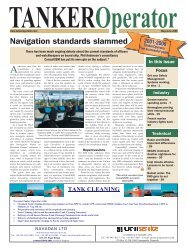Features: - Tanker Operator
Features: - Tanker Operator
Features: - Tanker Operator
Create successful ePaper yourself
Turn your PDF publications into a flip-book with our unique Google optimized e-Paper software.
Anthony Veder’s innovative hybrid gas carrier - the 7,500 cu m LNG/LEG/LPG carrier<br />
Coral Methane* - is due to enter service in December this year.<br />
She was launched at the Gdansk<br />
shipyard of Remontowa on 7th<br />
May this year and is being built on<br />
an owner/supplier basis.<br />
Anthony Veder's managing director Jan<br />
Valkier explained that the company was in<br />
total control of the shipbuilding process, due<br />
to the Coral Methane's complex design. There<br />
were options attached to the original building<br />
contract but these have expired.<br />
The gas plant and tanks were designed and<br />
developed by TGE Engineering. The<br />
Hamworthy Svanehoj pumps had to be<br />
redesigned to cope with LNG and other<br />
gasses. Rolls-Royce supplied the complete<br />
power and propulsion package, which<br />
includes Bergen Diesel gas/diesel electric<br />
propulsion unit and a twin Azipull propulsion<br />
system for ease of manoeuvrability.<br />
Coral Methane is being built to Bureau<br />
Veritas Ice Class 1B and will fly the Dutch<br />
flag. She has been chartered to Gasnor for 15<br />
years but will used by other operators when<br />
not engaged in Gasnor's LNG trade, which<br />
will be mainly confined to the Norwegian<br />
coast. She has been fitted for ship-to-ship<br />
transfers and will also be able to load at most<br />
European gas receiving terminals, including<br />
the two being built in Rotterdam, acting as a<br />
North European/Norway/Baltic Sea feeder.<br />
Valkier admitted that the Coral Methane<br />
had a larger capacity than currently needed in<br />
Norway, but was convinced the trade will<br />
grow as several Norwegian controlled coastal<br />
vessels, such as ferries and offshore supply<br />
vessels, now use LNG as their main fuel<br />
source.<br />
Anthony Veder technically and<br />
commercially manages 15 LPG/Ethylene<br />
carriers and has another four under purely<br />
commercial management. The company<br />
operates its own commercial pool in which the<br />
other four vessels are included.<br />
Like everywhere else, crewing is a problem<br />
as the seafarers need a gas certificate and gas<br />
experience. The company has a pool of Dutch,<br />
Ukrainian and Indonesian officers and as<br />
salaries have been rising appreciably, Valkier<br />
thought that the incentives were in place to<br />
recruit proper candidates. Gas courses are<br />
available in Rotterdam and training is also<br />
undertaken on board ship.<br />
Anthony Veder operates a cadet programme<br />
where potential seafarers are taken on<br />
annually. Demands have also been put on the<br />
shore staff. For example, the safety and<br />
quality department used to consist of just one<br />
person, but now there are three people<br />
TECHNOLOGY - SHIP DESCRIPTION<br />
Hybrid gas carrier<br />
sets the standard<br />
employed. In general Valkier thought that the<br />
business was more demanding and there were<br />
occasions where the crew was less<br />
experienced than would be preferred resulting<br />
in more supervision being necessary.<br />
Veder favours the Dutch and Liberian flags<br />
and although most of the vessels trade in<br />
European waters, including the Mediterranean<br />
and the Baltic, two vessels have been trading<br />
for Japanese trading houses in Asia since 2000<br />
and another newbuilding will join them<br />
shortly.<br />
Three of the vessels have been built to<br />
Finnish/Swedish Ice Class 1A thus<br />
guaranteeing them winter shipments in the<br />
Northern Baltic, especially Finland.<br />
A few months ago, Veder purchased<br />
Bergesen Gas' Ice Class 1A 6,100 cu m BW<br />
Helen on the back of a charter from YARA to<br />
lift ammonia cargoes.<br />
The ships mainly lift petrochemicals (80%)<br />
and the remaining 20% of the cargoes are<br />
made up of LPG. Other projects could be on<br />
the horizon, including the carriage of CO 2 and<br />
the question of shipping carbon capture<br />
cargoes.<br />
Charterers' vetting procedures tended to be<br />
quite strict and Anthony Veder is also<br />
involved with the TMSA process. About 70%<br />
Once delivered, Coral<br />
Methane will be<br />
chartered to Gasnor<br />
for 15 years.<br />
August/September 2008 � TANKER<strong>Operator</strong> 43

















